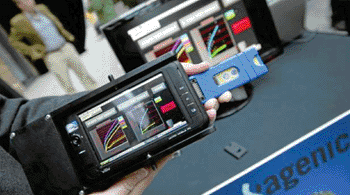Biosensors Enable Rapid Multiplexed Pathogen Detection
By LabMedica International staff writers
Posted on 27 Jun 2013
An electronic chip has been created that can analyze blood and other clinical samples for infectious bacteria with record-breaking speed. Posted on 27 Jun 2013
The advanced technology can identify the pathogen in a matter of minutes, and looks for many different bacteria and drug resistance markers in parallel, allowing rapid and specific identification of infectious agents.

Image: Platform for rapid molecular diagnostic testing (Photo courtesy of Xagenic Inc).
Biomaterial engineers and other specialists at the University of Toronto (ON, Canada) developed an integrated circuit that could detect bacteria at concentrations found in patients presenting with a urinary tract infection. The solution circuit chip (SCC) consists of 100 working electrodes (WEs) with 30 off-chip contacts. It included 20 common WEs and 5 counter/reference (CE/RE) electrode pairs, with 25 probe wells to facilitate manual probe deposition and five separate liquid channels. One key to the advance was the design of an integrated circuit that could accommodate a panel of many biomarkers.
A set of peptide nucleic acid (PNA) probes were designed, synthesized and tested, and validated for sensitivity and specificity. It is these probes that make individual sensors specific for pathogens, as they are targeted to unique sequences within the genomes of the organisms. The probe set developed covered 90% of the common urinary tract pathogens and many of the major types of drug resistance that are encountered in a clinic. The results indicate that SCCs can be used for highly multiplexed pathogen detection, and can also be used to deliver the very rapid results needed to make diagnostic information clinically available.
Ihor Boszko, MSc, MBA, Director of Business Development at the molecular diagnostics company Xagenic (Toronto, ON, Canada) said the breakthrough could have significant practical implications. “This kind of highly sensitive, enzyme-free electrochemical detection technology will have tremendous utility for clinical diagnostics. Multiplexing of in vitro diagnostic approach adds the capability of simultaneously testing for multiple viruses or bacteria that produce similar clinical symptoms. It also allows for simple and cost effective manufacturing of highly multiplexed electrochemical detectors, which will certainly have a significant impact on the availability of effective diagnostic tools.” The study was published on June 12, 2013, in the journal Nature Communications.
Related Links:
University of Toronto
Xagenic














